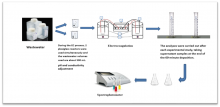- gnest_03683_published.pdf
-
Paper IDgnest_03683
-
Paper statusPublished

Discharging wastewater from industries without any treatment causes environmental pollution and endangers biotic life. In this study, pollutant removal by electrocoagulation (EC) process was investigated using wastewater of the ore processing plant (magnesite crushing and screening plant). In the EC process, iron-iron and copper-copper electrodes were used in parallel in the reactor. Chemical oxygen demand (COD), Sulphate, Chromium (VI), Nickel, Zinc, Magnesium, and Total Suspended Solids (TSS) removals were investigated in the EC process of mineral processing industry wastewater with the iron electrode. These pollutants were calculated as %97.6, %95.1, %98.2, %98.1, %97.8, %88.2, and %98.9, respectively. COD, Sulphate, Chromium (VI), Nickel, Zinc, Magnesium, and TSS removals in the EC process of mineral processing industry wastewater with the copper electrode are %92.8, %94.9, %99.5, %98.7, %96.1, %91.6, and %96.9 respectively. It has been observed that high removal efficiency can be achieved by using the electrocoagulation process in the treatment of ore washing wastewater resulting from the crushing and screening processes in the Chrome Magnesite processing plant.
Total file downloads: 6